Press Area Setup: Comprehensive Guide for Seamless Event Coverage
Updated On: November 13, 2025 by Aaron Connolly
Core Principles of Press Area Setup
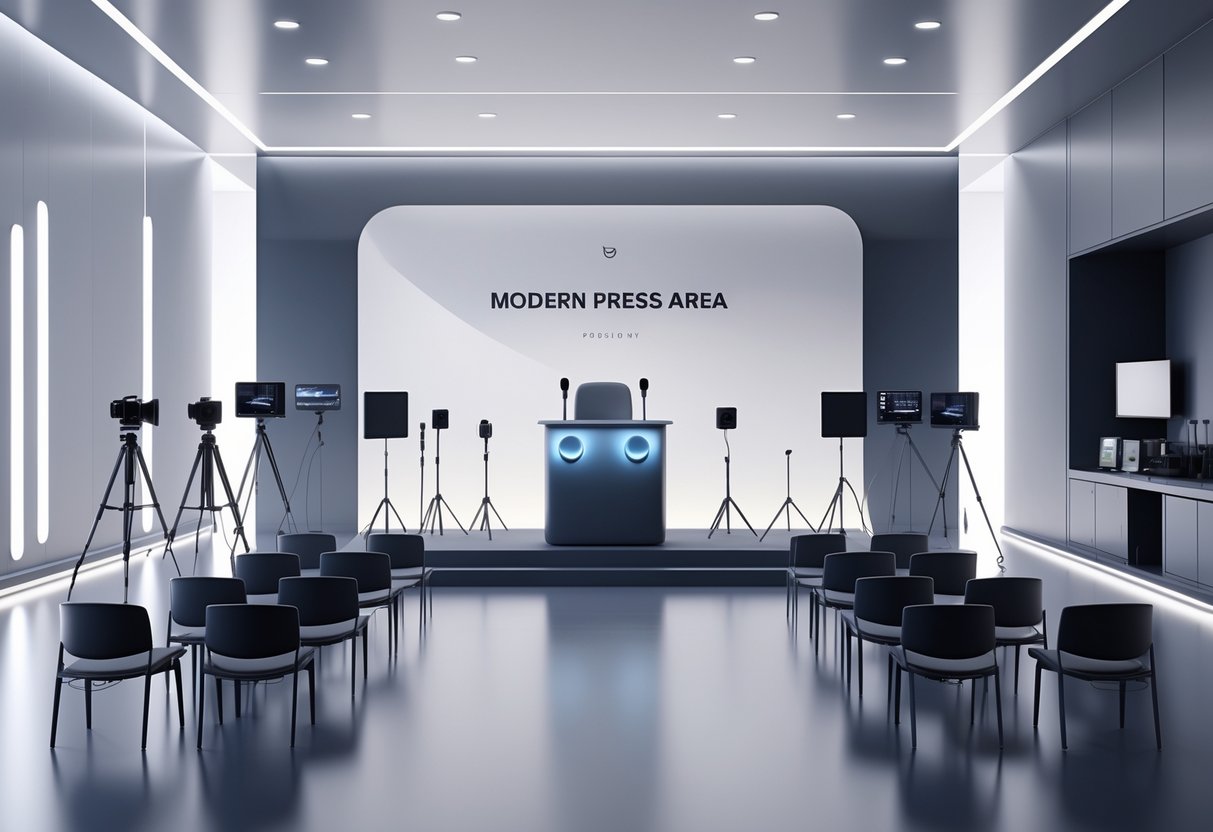
Nailing your press area setup means you have to juggle journalist demands with event logistics, all while building spaces that hold up under pressure. You need to really get how media folks work during live events and create areas that help them meet tight deadlines and handle their tech.
Role of Press Areas in Event Success
Press areas shape how well your event gets media coverage. If journalists can’t work efficiently, your event misses out on good press.
A solid press area gives reporters what they need: reliable WiFi, plenty of outlets, and clear views of the action. If you mess up the setup, journalists get frustrated, maybe leave early, or just skip your event.
Press areas also help control media access. You can hand out press kits, set up interviews, and organize photo ops right there. That keeps things orderly but still gives journalists the content they’re after.
Esports tournaments especially need good press areas. Gaming reporters have to capture screen content, grab player interviews right after matches, and send out real-time updates. The space has to work for both traditional sports writers and digital creators, who all bring different gear.
Balancing Media and Organiser Needs
Event organisers want to keep media coverage controlled and predictable. Journalists, on the other hand, want access and flexibility to get the best stories. Good press area design can bridge this gap.
Clear boundaries help everyone. Photo zones keep journalists from blocking fans while still giving them great shots. Interview areas keep things organized but make sure media get real quotes.
Registration spots near entrances help manage journalist flow. You can check credentials, hand out materials, and brief reporters on what’s happening. It keeps out people who shouldn’t be there but still makes legit media feel welcome.
You have to plan out the technical side, too. Power, internet, and lighting needs are all over the place depending on whether you’re dealing with print, broadcast, or streamers. If you overdo it, you waste money, but if you don’t provide enough, coverage suffers.
Fundamental Layout Considerations
The location of your press area makes or breaks how well journalists can do their jobs. If it’s too far from the action, they miss out. Too close, and you risk distractions and security headaches.
Sightlines usually matter more than just being close. Elevated spots often beat front-row seats. Journalists need to see scoreboards, player reactions, and the crowd. Sometimes, side angles actually give better shots than straight-on views.
You want good traffic flow to avoid jams when news breaks. Entry and exit points should handle a rush. Interview zones need to be easy for talent to reach but not right in the middle of fans.
| Layout Element | Purpose | Key Requirements |
|---|---|---|
| Registration desk | Credential checking | Near entrance, secure storage |
| Work stations | Writing and editing | Power, WiFi, adequate lighting |
| Interview area | Player/official access | Quiet, good acoustics, backdrop |
| Photo positions | Action shots | Clear sightlines, stable platforms |
You need storage for all the gear journalists bring—cameras, laptops, recorders, and so many cables. Secure storage keeps expensive equipment safe and walkways clear.
Selecting the Ideal Space
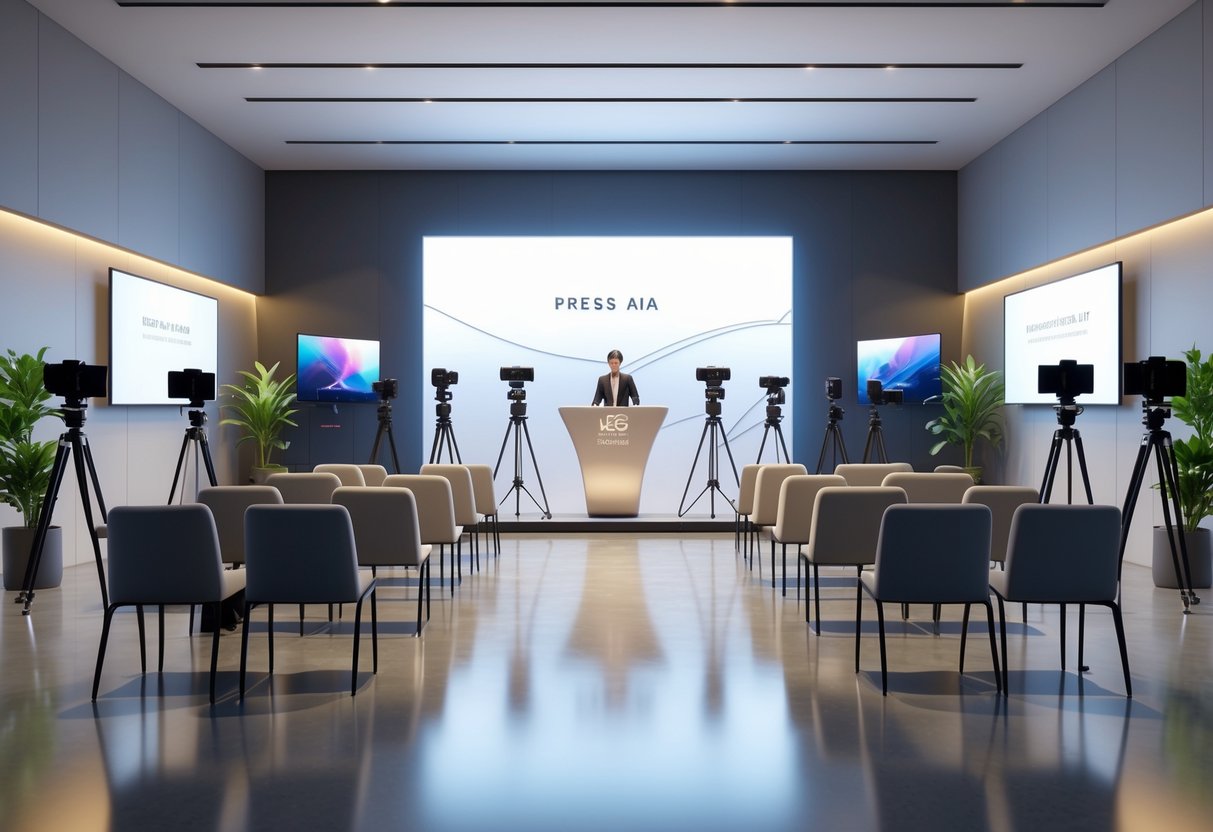
Picking a good press area location makes a big difference for both coverage quality and the journalist experience. You have to balance accessibility, technical needs, and visibility to create a space that actually works.
Venue Assessment Strategies
Start by mapping out the venue before you pick a press zone. Walk around at different times to see how lighting and crowds change.
Physical Requirements Checklist:
- Power access – Plenty of outlets within 3 metres
- Internet connectivity – Wired and wireless, both if possible
- Climate control – Good ventilation for all the hot equipment
- Noise levels – Try to avoid crowd noise and loudspeakers
Watch out for low ceilings that can mess with camera setups. Some venues have weird fixtures hanging down.
Measure the space carefully. You’ll want at least 2 metres between workstations so camera crews aren’t bumping into each other.
Accessibility factors:
- Ground-level access for moving gear
- Close to parking for broadcast trucks
- Good views of the main event
- Separate entrance so you don’t get stuck in the crowd
Aligning Space with Event Type
The type of tournament really affects your setup. Single-elimination events need a different press area than round-robin formats.
For live broadcast coverage, stay near the main stage with clear views. Streaming setups need steady tables and several camera angles.
Interview zones work best just outside player warm-up spaces, where journalists can catch players between matches.
Think about timing, too. Multi-day events need secure overnight storage for gear. Weekend tournaments might need different access than weekday ones.
Space allocation guidelines:
- Written press: 1.5 metres per journalist
- Broadcast crews: 4-6 metres including equipment
- Interview areas: At least 3 metres for decent audio
Adjust your layout based on how many people you expect. Smaller tournaments need flexible spaces that can grow fast if more people show up.
Space Optimisation Techniques
Make the most of your press area with smart furniture and gear placement. Modular tables let you switch things up between rounds.
To improve visibility:
- Use elevated platforms for cameras
- Place lights to cut down on glare
- Make sure everyone can see scoreboards and timers
- Set up different viewing angles for different stories
Divide your space into zones. Keep writing areas quiet and broadcasting zones active so people aren’t talking over each other.
Go vertical with storage for cables and backup gear. Wall-mounted power strips keep floors clear.
Put your busiest spots near toilets and catering. That way, journalists don’t have to trek across the venue for a quick break.
If the venue doesn’t have a permanent press area, go portable. Folding screens can make a decent backdrop for interviews even in basic spaces.
Designing Effective Press Area Layouts
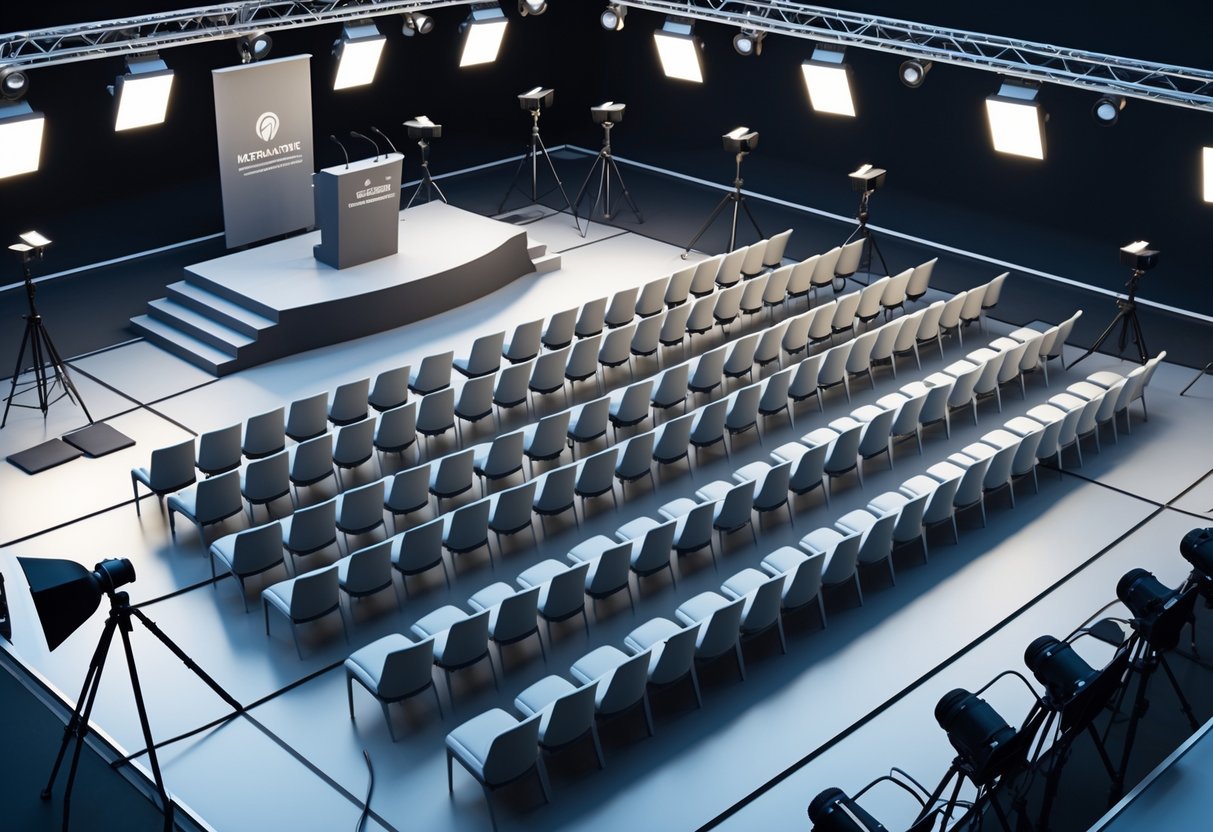
Your press area layout can make or break a press conference. Where you put the stage, seats, and equipment zones decides whether journalists get the shots and sound they need.
Stage and Podium Placement
Put the stage or podium where every journalist has a clear view. The speaking area should be at the front, well-lit, and easy to hear.
Distance is key for good visibility. Place the podium at least 3-4 metres from the first row so cameras don’t block anyone else.
Height helps with sightlines. In big rooms, raise the stage 30-60 centimetres so everyone in the back can see.
Test audio equipment from different spots. Make sure microphones cover the whole area without weird feedback.
Backdrops matter for branding. Stick company logos or banners right behind the podium so they show up in every shot.
Seating Arrangements for Media
Arrange seats in rows or semi-circles to give everyone a good view. Put photographers in the front so they can get close.
Reserved sections keep things smooth. Block off spots for different media:
- Print journalists: Middle rows, with tables for laptops and notebooks
- Photographers: Front row, with space to move around
- TV crews: Sides or back, with power for their gear
Leave wide aisles between sections for cables and people moving around. Conference chairs are fine, but make sure they’re stable and have enough leg room.
Name cards or simple signs help journalists find their seats fast. Place them on chairs or tables before the event starts.
For bigger press conferences, tiered seating helps. That way, tall folks don’t block the view for everyone else.
Camera and Equipment Zones
Set up dedicated camera zones that don’t block others or create safety issues. TV cameras need steady spots with clear shots of the podium.
Plan power needs ahead of time. Put plenty of outlets near camera spots and along seating rows. Tape down extension cords so nobody trips.
Equipment tables help keep things organized. Place them at the back or sides for:
- Audio recorders
- Laptops and charging stations
- Camera bags and extra lenses
- Press kits and promo stuff
Designate clear paths for camera operators to move without bumping into others. These should go from equipment zones to the best filming spots.
Lighting affects video quality. Avoid putting cameras under harsh overhead lights that cast shadows. Side lighting usually looks better on camera.
Keep sound gear close to the podium but not in busy walkways where it might get knocked over.
Prioritising Accessibility in Press Areas
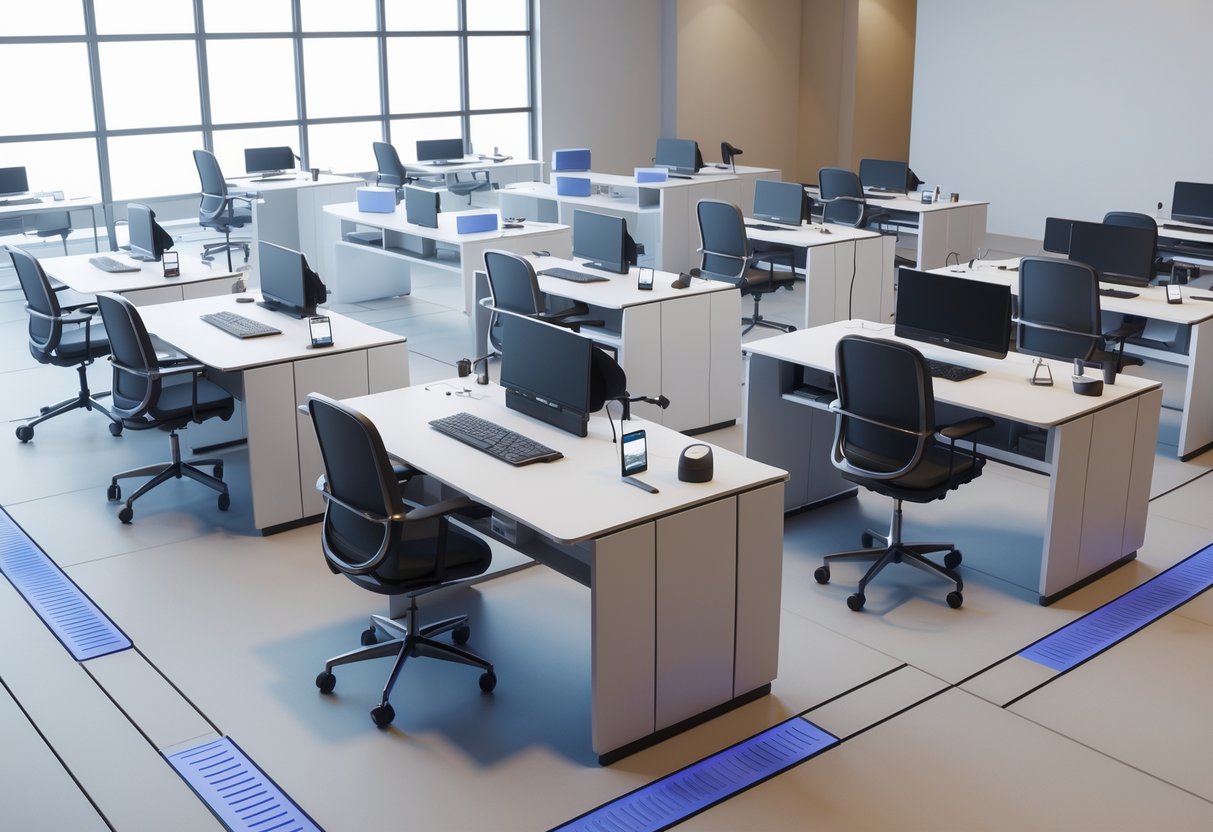
Press areas have to work for journalists with all kinds of mobility and accessibility needs. You need wide paths, inclusive seating, and good emergency exits so everyone can do their job safely.
Pathways and Mobility Solutions
Make sure your main walkways are at least 1.2 metres wide so wheelchairs and mobility aids fit comfortably.
Key pathway features:
- Flat surfaces, no steps or sudden height changes
- Non-slip floors, especially near gear
- Good lighting everywhere (at least 200 lux)
- Clear, high-contrast signs
Manage cables carefully. Tape down or ramp all power and ethernet cords. Loose cables are a real hazard, especially for people with vision or mobility challenges.
Think about how people move between key spots. Journalists should get from their seats to registration, tech support, and snacks easily. Mark these routes with tactile guides if you can.
Accessible Seating Provision
Accessible seating should blend in, not stick out. Try to set aside at least 5% of press seats for accessibility.
Seating tips:
- Removable chairs for wheelchair users
- Clear views of speakers and screens
- Companion seats for assistants or interpreters
- Easy access to power and internet
Height-adjustable tables are a big help. Standard tables at 76cm work for most, but adjustable ones (71-81cm) include more people.
Put accessible seats near tech support if possible. That way, help is close without bothering everyone else.
Emergency and Ease-of-Exit Planning
Evacuation plans have to work for everyone, including journalists with mobility or sensory issues. Set up more than one exit route, and don’t rely only on stairs or narrow doors.
Emergency must-haves:
- Both visual and audible alarms
- Assistance areas by exits
- Clear, pictogram-rich signs for evacuation routes
- Staff trained in disability awareness and emergencies
Keep exit routes clear—camera tripods and cases often end up blocking the way during busy events.
Share emergency info in several formats: large print, digital, and audio. Assign staff to help anyone who might need extra support getting out.
Check safety features often. Test ramps, lighting, and alarms before every event.
Ensuring Media Visibility and Comfort
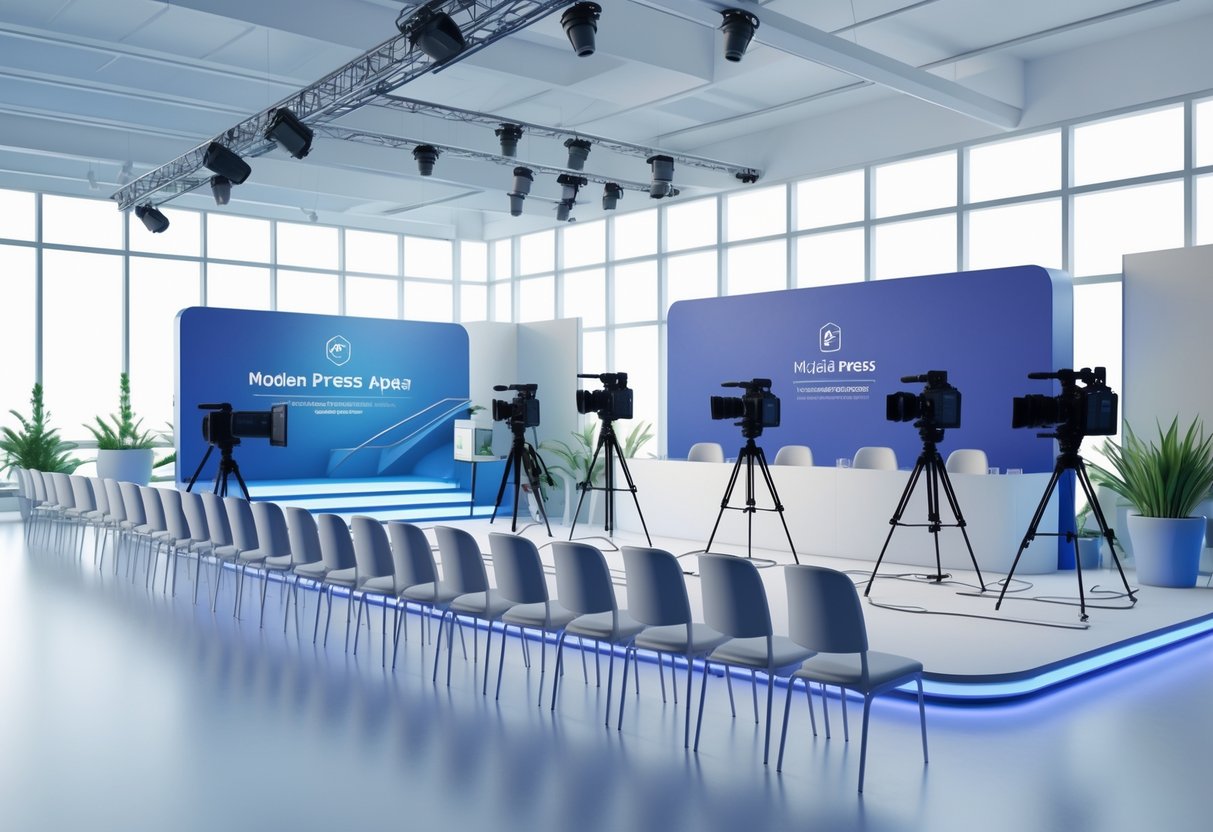
If journalists can see well and work comfortably, your press area does its job. Good sightlines and a solid technical setup let reporters focus on telling your story instead of fighting the environment.
Optimal Sightlines for Journalists
Let’s put journalists where they can actually get the best shots, without tripping over each other in the process. The front row? That’s for photographers—they need those clear, unobstructed views of speakers.
Camera placement works out best if we go for a tiered system. Photographers get floor-level access at the very front. Video crews need to be just behind them, up on risers or platforms, so they can shoot over everyone’s heads.
Print journalists? They can sit farther back, since hearing is their main concern. We should leave 2-3 feet between each camera setup so equipment isn’t colliding left and right.
Key positioning guidelines:
- Place the podium 8-10 feet from the front row
- Keep the main speaking area well-lit and clear of obstacles
- Set the backdrop 3-4 feet behind the speakers
- Leave a center aisle for late arrivals
At press conferences, we need to make sure the main focal point is visible from several angles. Side shots usually end up looking better than dead-center, honestly.
Avoid classic mistakes like putting tall gear in front of smaller setups. The speaker platform should be a bit raised so those in the back can actually see, not just the backs of heads.
Lighting and Audio Considerations
Good lighting is the difference between professional-looking coverage and footage you can’t use. We want bright, even lighting across the whole stage—no weird shadows, please.
Audio setup needs to cover all the bases. Handheld mics work great for Q&A, while lapel mics are better for long speeches. We should always offer a direct audio feed for broadcast crews.
Key lighting requirements:
- At least 500 lux on the speaker’s face
- Even lighting on the backdrop
- No harsh backlighting that turns people into silhouettes
- Backup lights in case the power goes out
Sound matters—it’s not just about volume. We need to cut out echo and background noise. Hard surfaces bounce sound around, so adding soft materials helps a lot.
Technical details:
- Audio feed should be at line level
- XLR connections for pro gear
- Test every system 30 minutes before go-time
- Keep backup microphones on hand
When the audio’s bad, journalists end up working overtime just to transcribe quotes. Clear sound lets them actually pay attention and ask better questions.
Technical Infrastructure and Equipment
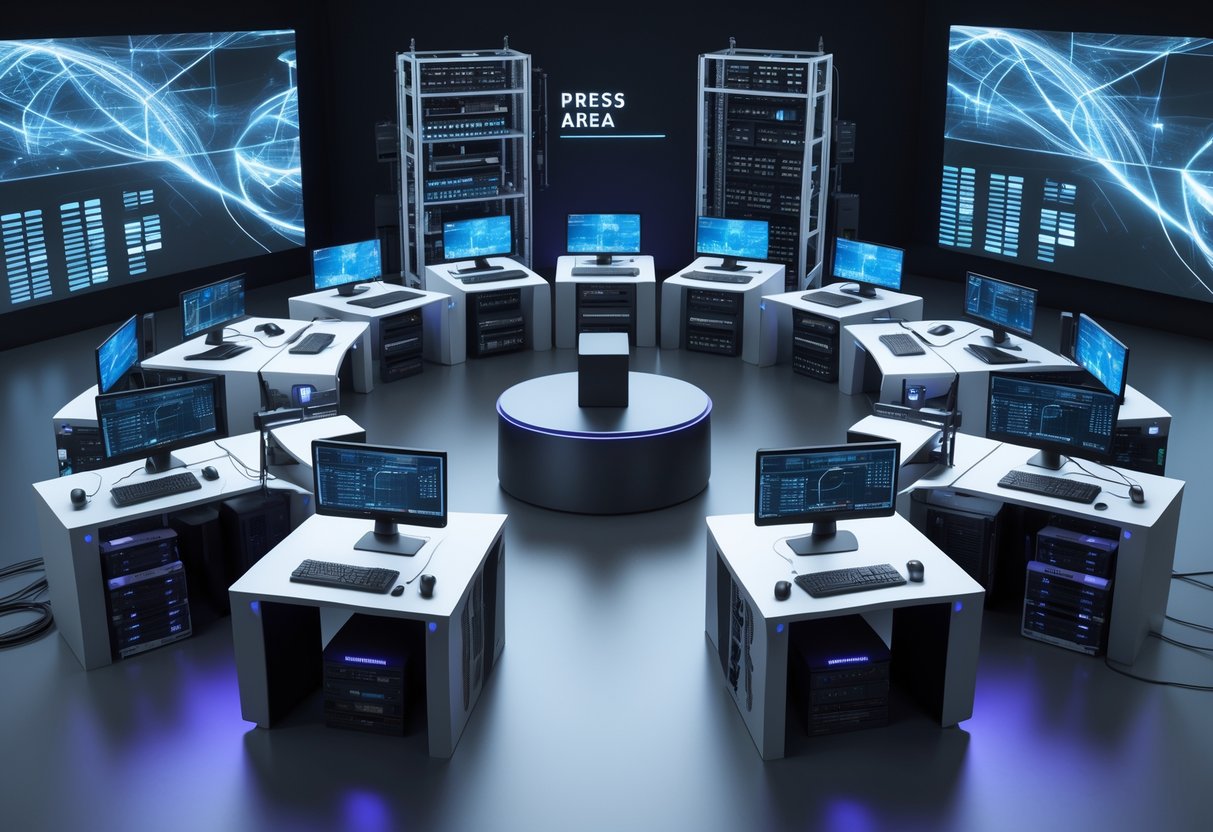
Getting the technical infrastructure right can make or break your press area. You’ve got to nail the audio-visual systems, make sure the power and internet won’t quit, and store all that expensive gear somewhere safe.
Audio Visual Setup Essentials
Audio systems are the heart of a good press area. You’ll want wireless mics with at least 8 channels for simultaneous interviews. Boom poles and clip-ons work for different interview setups.
Camera positioning needs some forethought. Set up camera zones with floors that handle tripods. Leave 2-3 meters between cameras so nobody is bumping into each other.
Lighting equipment shouldn’t be an afterthought. LED panels are best—they’re adjustable and don’t get hot. Put main lights at 45-degree angles to avoid weird shadows.
Display monitors let journalists keep an eye on live feeds. Mount 32-inch screens at eye level around the press area. Reporters can see what’s being broadcast, right as it happens.
Audio mixing desks pull all the sound together. Pick models with USB so you can stream directly. This setup supports both old-school broadcast and digital streaming at the same time.
Power, Internet, and Connectivity
Power distribution takes planning. Stick power strips every 2 meters along the press seating. Use surge protectors rated for broadcast gear—15 amps at least.
Internet connectivity has to handle a lot of uploads at once. Give each press spot its own ethernet port. Wi-Fi should support at least 50 devices without slowing down.
Backup power systems are a must. UPS units should keep the essentials running for at least 30 minutes. That’s enough time to switch to a generator if things go south.
Cable management keeps everything safe and tidy. Use ramps where cables cross the floor and overhead trays when you can. Label everything for quick fixes.
Network redundancy is smart—use more than one internet provider. Load balancers will switch connections automatically if one drops.
Equipment Storage Solutions
Secure storage keeps gear safe when it’s not being used. Lockable cabinets should fit cameras, laptops, and audio gear. Place storage within 10 meters of the press area for quick access.
Climate control matters. Keep storage areas between 15-25°C, humidity below 60%. Sensitive electronics last longer that way.
Equipment check-out systems help you track who’s using what. Digital logs cut down on losses. Barcodes work well for big events with lots of outlets.
Transport cases with padded inserts protect gear during setup and teardown. Wheeled cases save your back when moving heavy stuff.
Insurance usually requires certain locks and storage conditions. Double-check with your insurer before you finalize storage plans.
Integrating Data and Business Intelligence
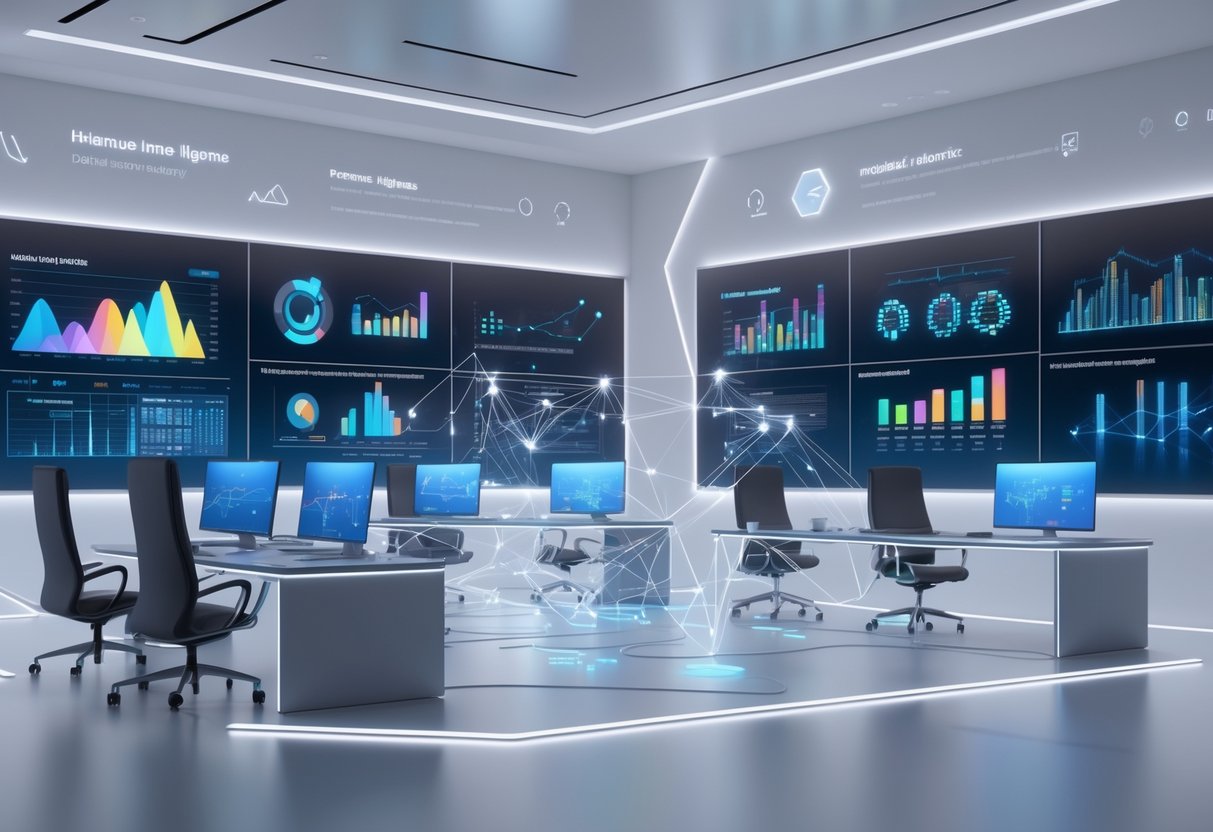
A smart press area setup depends on collecting the right info before and during events, then using that data to make quick calls. We can track everything from media attendance to equipment needs, turning numbers into better layouts and smoother operations.
Collecting and Cleaning Event Data
We need clean, accurate data to make smart choices about press areas. Start by gathering info from past events—media attendance, equipment requests, feedback forms, all of it.
Key data sources:
- Registration systems with confirmed media
- Past attendance by event type
- Equipment checkout logs
- Post-event journalist surveys
- Social media mentions and engagement
Clean up your data—remove duplicates, fix mistakes, and fill in missing info. Store everything in one place so the team can find it easily.
Set up automated data collection when you can. QR codes for gear checkout or digital feedback forms save time and cut down on errors.
Track details like arrival times, seating preferences, and tech support requests. These patterns help us improve setups next time.
Leveraging Analytics for Setup
Turn raw data into actual setup plans with BI tools. Look for trends in media behavior, peak usage, and space needs from past events.
Analytics can show:
- The right press area size based on registrations
- Best spots for different media types (TV crews vs. photographers)
- How equipment gets distributed
- Where traffic jams happen
Build predictive models with historical data. If events usually get 20% more media than registered, plan for it. Cluster media by needs—broadcast crews need more space than print folks.
Create simple dashboards with key stats. Show real-time registration, weather forecasts, and available equipment.
Test different layouts using your data. Compare with similar past events to see what worked. Save the best setups for next time.
Real-Time Data for On-Site Adjustments
Track live data during events so you can adjust on the fly. Use apps or tablets to watch attendance, equipment issues, and space usage as they happen.
Set alerts for important thresholds. Get a ping when the press area hits 80% capacity or if key gear fails. That way you can fix things before they get out of hand.
Real-time tracking tools:
- Digital check-in showing actual vs. expected attendance
- Equipment status monitors
- Staff apps for instant updates
- Live feedback collection on tablets
Have backup plans ready for specific situations. If attendance jumps by 25%, roll out your expansion plan. Pre-position extra gear based on usage patterns.
Keep communication simple. Share updates with your team right away. If one area gets crowded, coordinate with security and logistics to move people or open up more space.
Press Conference Operations and Flow
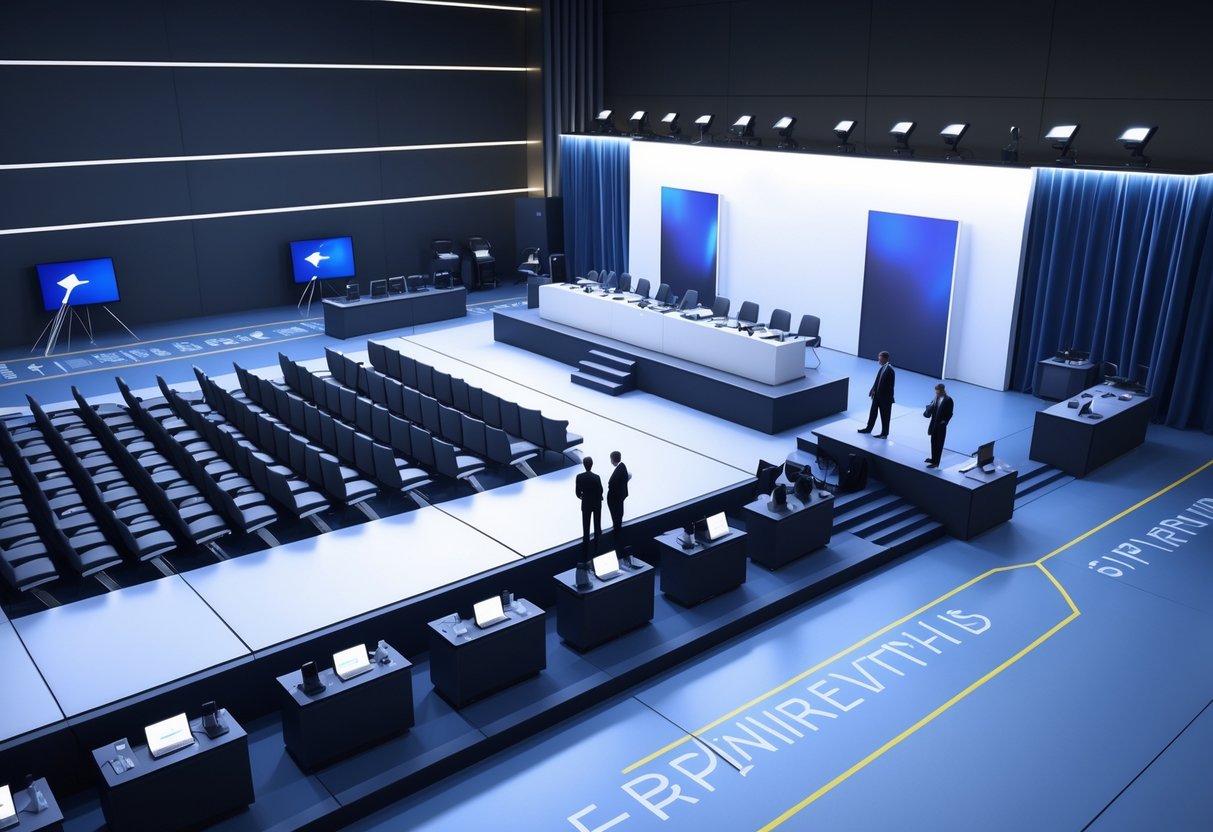
Smooth operations let journalists focus on your message and keep things professional. Good registration systems stop bottlenecks, structured Q&A makes media access fair, and dedicated interaction spaces help build relationships with the press.
Managing Registration and Check-In
Set up registration near the main entrance to control event flow from the get-go. That first impression? It really counts for credibility.
Make check-in simple—use a guest list and name badges. At least two staffers should handle registration so queues don’t pile up when everyone arrives at once.
Prep press kits with key info, company background, and speaker bios. Put these at the registration desk for easy pickup.
Quick tip: A digital check-in system on tablets speeds things up and keeps attendance data accurate.
Keep the registration table out of the main entrance path. Leave space so journalists can head straight into the event after checking in.
Set up a separate spot for late arrivals to avoid disrupting the main session. Brief your staff on handling media credentials and any special access.
Coordinating Q&A Segments
Plan Q&A timing so you keep journalists engaged but don’t lose control of your message. Most press conferences give 15-20 minutes for questions after the main talk.
Pick a moderator to run the Q&A and keep things on track. Don’t use your main speaker—they need to focus on delivering their message.
Put microphones in the audience for clear audio. For big venues, have staff with roving mics for those who can’t get to the fixed ones.
Lay out ground rules at the start: one question per journalist, follow-ups if there’s time. This keeps things fair for everyone.
Keep a list of likely questions and prep short, clear answers. Speakers should practice staying on message but still sound natural and approachable.
Media Interaction Areas
Set up spaces where journalists can do interviews after the main session. This stops crowding around speakers and lets conversations get more personal.
Pick a spot with good lighting and low background noise. Keep it away from the main event so you’re not distracting others.
Offer charging stations for media gear—journalists often show up with half-dead batteries. It’s a small thing, but they’ll appreciate it.
Make sure your PR team is around to coordinate interviews and photo ops. Schedule these ahead of time when you can.
If it’s a long event, think about a media lounge with drinks and snacks. It encourages journalists to stick around and network.
Next step: Walk through your whole venue flow—from registration to media areas—and time each part to spot any bottlenecks before the event.
Collaboration with Event Management Teams
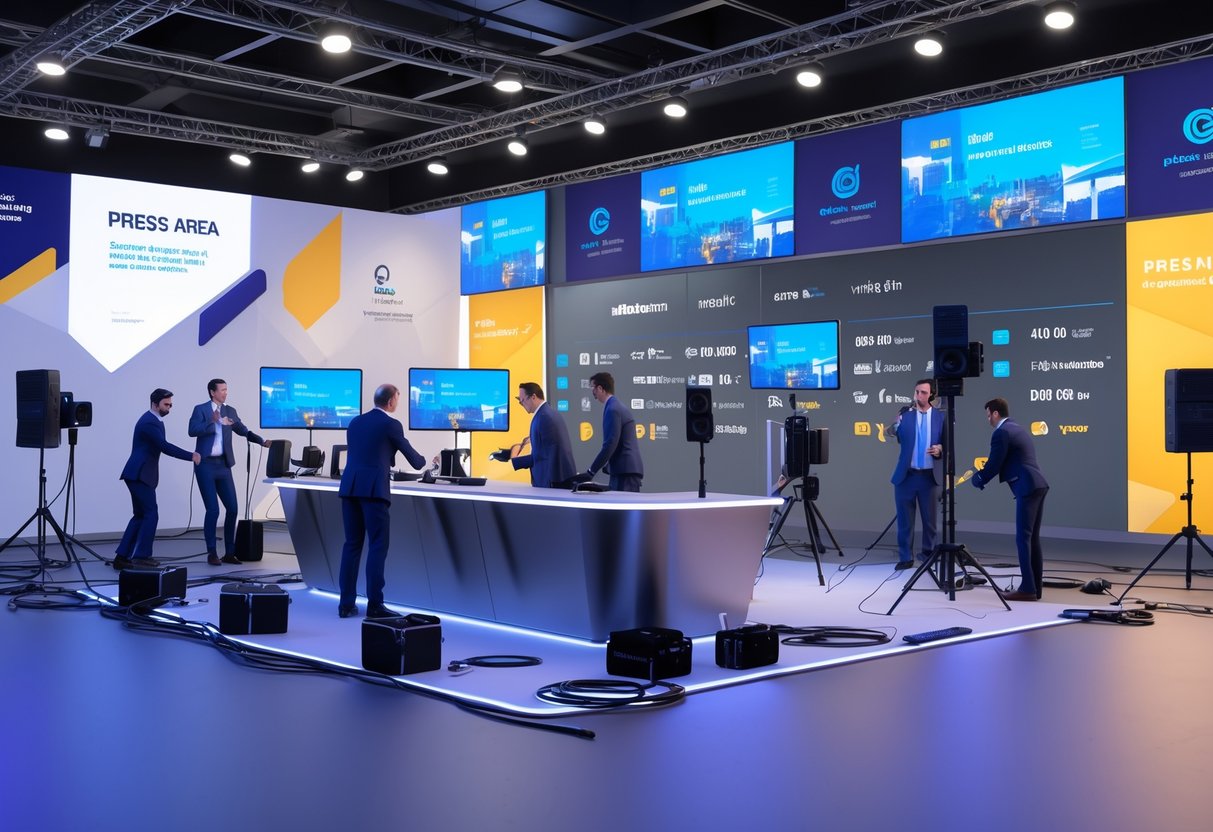
A great press area setup depends on solid teamwork between media coordinators and event managers. Good communication and synced timelines mean journalists get what they need, and the event runs without a hitch.
Communication Protocols
We need to set up clear channels between press coordinators and event managers from day one. Teams should use dedicated messaging apps or project management tools to keep everyone updated about venue changes, speaker schedules, and tech needs.
The press team must get instant updates about program changes. Last-minute shifts can throw off media plans and frustrate journalists on deadline.
Assign specific contacts for different event areas—one for venue logistics, another for speaker schedules and interviews.
Key communication must-haves:
- Daily briefing calls
- Shared digital calendars for all milestones
- Emergency contact lists for both teams
- Clear steps for urgent issues
Regular check-ins help small problems stay small and keep press coverage on track.
Synchronising Event Timelines
We align the press area timeline with the main event schedule. Coordinate setup so media spaces are ready before journalists show up for accreditation and briefings.
Event managers should provide detailed run-sheets with speaker arrivals, presentations, and networking breaks. This helps us schedule interviews and photo ops without overlap.
Timeline coordination includes:
- Press setup finished 2 hours before the event starts
- Interview slots between main sessions
- Photo ops during natural breaks
- Tech rehearsals outside of venue prep
Build in buffer time for delays or last-minute speaker changes. If timelines shift, event managers need to let us know right away so we can adjust press schedules too.
Challenges and Solutions in Press Area Setup

Setting up press areas for esports events isn’t easy—it’s full of little headaches that can seriously affect media coverage. Quick thinking and solid planning usually save the day when you run into last-minute equipment failures or cramped spaces.
Dealing with Last-Minute Changes
Tournament organizers often deal with sudden changes just hours before everything kicks off. Streaming equipment might suddenly stop working, or more media outlets show up than anyone expected.
We suggest keeping 20% extra seating open for those last-minute press arrivals. Esports events often misjudge how many journalists will actually turn up, especially when it’s the finals.
Quick backup solutions:
- Portable ethernet cables for internet hiccups
- Extra power strips and extension leads
- Mobile hotspots ready to go
- Foldable tables and chairs stashed in storage
Gaming journalist Aaron Connolly once said, “having backup streaming equipment saved our coverage when main systems crashed during a crucial match finale.”
Write up a rapid response checklist for power, internet, seating, and equipment failures. Assign staff members to handle each emergency type so people know who’s doing what.
Common Pitfalls and How to Avoid Them
A lot of events put the press area way too far from the action. Esports journalists need to see player reactions and feel the crowd energy—otherwise, what’s the point?
Avoid these setup errors:
| Problem | Solution |
|---|---|
| Poor internet speed | Test bandwidth with 10+ devices before the event |
| Blocked camera angles | Put press 45 degrees from main screens |
| Not enough power outlets | Plan 3 outlets per journalist workstation |
| No quiet interview space | Reserve a separate room for player interviews |
Venues sometimes forget that esports coverage needs different gear than traditional sports. Gaming journalists need sturdy surfaces for laptops and lots of charging points.
Heads up: Don’t put press seating right behind audience members with signs or flags—they’ll block camera shots every time.
We’ve watched tournaments lose out on great coverage just because they skipped basics like proper lighting for video interviews.
Security and Safety Considerations
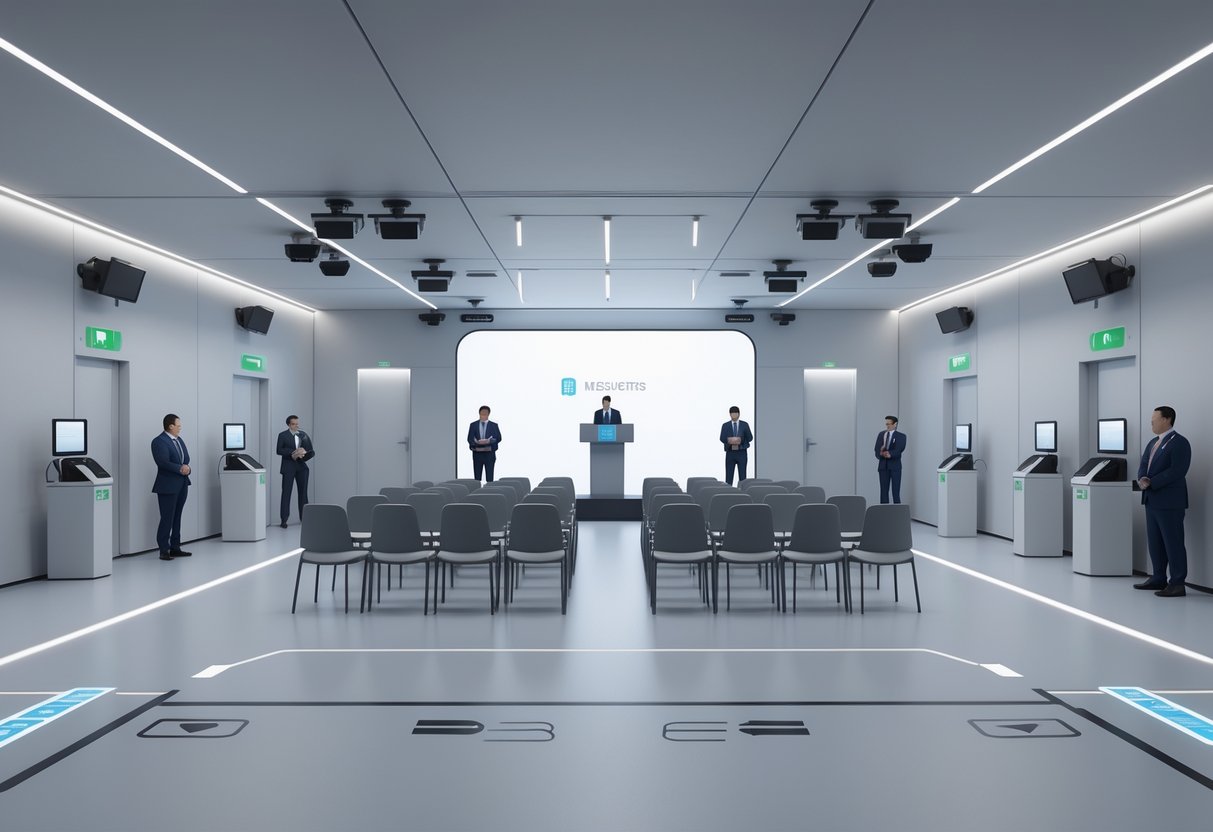
When you set up press areas for esports events, you’ve got to think about security protocols and crowd management. These keep gear safe, the event running smoothly, and everyone protected.
Access Control Measures
You should set up several layers of access control to keep expensive equipment secure and maintain fair play. Start with physical barriers—retractable belts or temporary fencing work well.
Key access controls:
- Wristbands or lanyards in different colors for press, staff, and VIPs
- Security checkpoint at the press area entrance
- Locked cabinets or cases for storing equipment
- Dedicated WiFi just for press
Have security staff check credentials at least twice during busy periods. A lot of events now use RFID-enabled passes to track who comes and goes.
Don’t forget digital security. Set up a separate network for media. Change WiFi passwords daily and cap bandwidth per user so everyone gets a fair share.
Keep a log of all gear coming in and out. This helps prevent theft and keeps tabs on expensive cameras, laptops, and broadcasting gear.
Crowd Flow Management
You need clear paths that keep spectators away from press operations. Design the press area with entry and exit points that don’t cut through the main crowd.
Crowd management basics:
- Put press seating behind the spectator area if you can
- Create dedicated corridors for interviews and moving equipment
- Use clear signage for press-only zones
- Schedule press activities during quieter moments
Mark press boundaries with floor tape or temporary barriers. This keeps fans from wandering in but still lets journalists see the action.
Emergency planning really matters. Make sure press areas have alternative exits that don’t go through packed spectator sections. Brief all media folks on evacuation procedures when they check in.
Think about peak crowd times when planning press conferences or interviews. Schedule these during match breaks, not when the crowd’s most hyped.
Finalising, Inspecting, and Adapting the Press Area
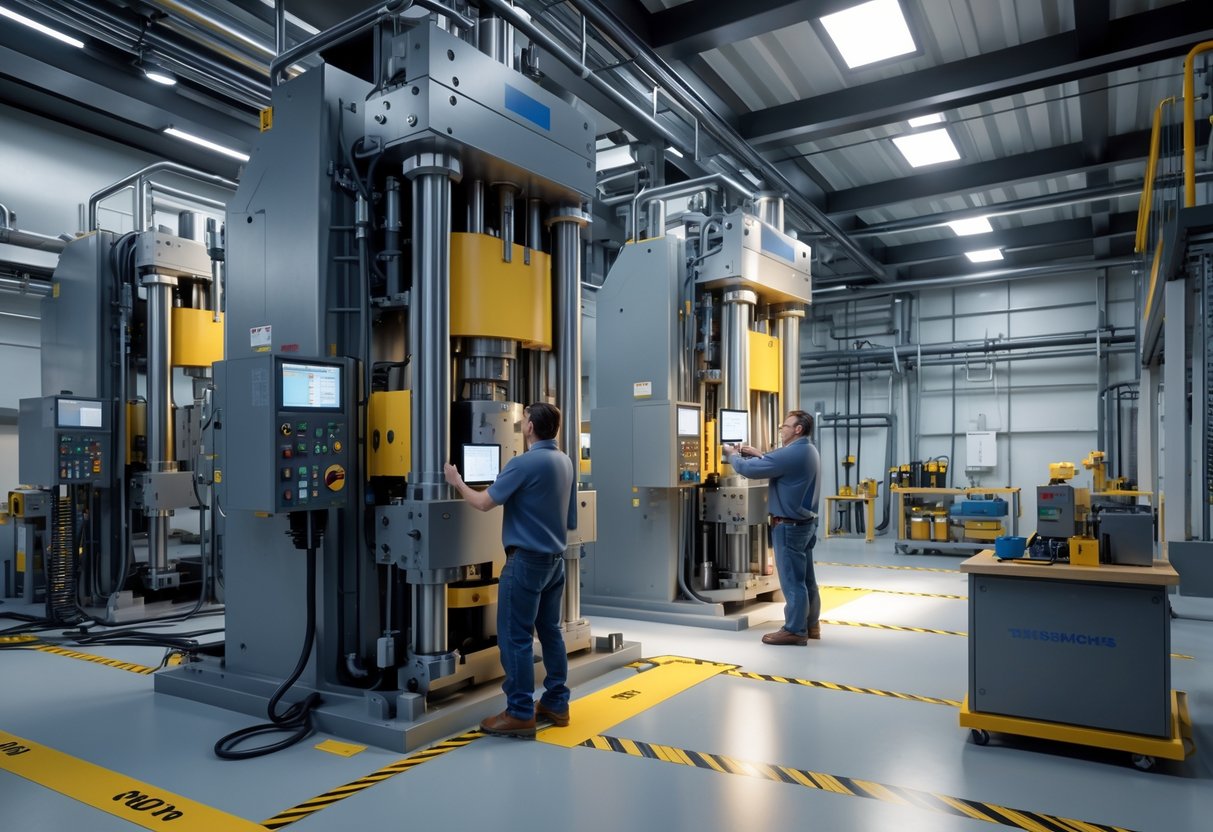
Getting your press area ready means double-checking that everything works before the media shows up. You’ll also want a way to gather feedback so next time goes even better.
Pre-Event Testing and Walkthrough
Test all technical gear at least 2 hours before the event. Make sure internet upload speeds hit at least 25 Mbps for live streaming. Try every power socket and have backup cables handy.
Walk the space as if you’re a journalist with a pile of camera gear. Can you find the registration desk easily? Is there enough space for a tripod without blocking people?
Checklist for the basics:
| Area | Check Points |
|---|---|
| Power | All sockets work, extension leads are secure |
| Internet | Wi-Fi password in view, ethernet ports work |
| Seating | Clear view of the stage, enough space |
| Equipment | Microphones, cameras, lighting all tested |
Have someone from the event team ready to answer media questions during the walkthrough. They need to know the backup plans if something breaks.
Run a mock press conference 30 minutes before doors open. This helps catch problems like bad acoustics or weird lighting that messes up video.
Feedback Collection for Continuous Improvement
Set up a simple feedback system during the event. Put QR codes on tables linking to a quick survey about internet quality, comfort, and tech support.
Ask experienced journalists what worked and what annoyed them. They’ll notice things like needing more table space or better camera spots.
Track these metrics for press areas:
- How many journalists needed tech help
- Average time at the registration desk
- Most common complaints or requests
Hold a post-event debrief within 48 hours while memories are fresh. Include feedback from the event team about setup slowdowns or confusion.
Tip: Keep a small notebook handy during events for jotting down quick notes. Sometimes, these real-time observations catch issues formal surveys miss.
Store all feedback in a shared doc for your team to check before the next event. Even small tweaks—like adding phone chargers or moving the coffee station—can make a big difference for the media.
Frequently Asked Questions

Setting up a press area isn’t just about putting out a few tables. You’ve got to think about equipment, access, and creating a spot where journalists can actually work. Here are some questions that come up all the time when prepping media zones at esports events.
What are the essentials for creating an effective press area at an event?
Focus on three things: dedicated workspace, solid internet, and easy access to the event floor. Your press area needs tables with power outlets for every journalist.
Put the press area close to the main stage but far enough from the crowd so noise doesn’t overwhelm everyone. Journalists need a clear view and a professional space for writing and filming.
Set up a registration desk at the entrance so media can check in and grab press kits. This keeps track of attendees and makes sure everyone has what they need.
Could you suggest some best practices for managing crowd flow in media zones?
Set up separate entrances for media and the general crowd. This avoids bottlenecks and gives journalists quick access when it matters most.
Use barriers—rope lines or temporary fencing—to separate the press area from spectators. Keep pathways wide enough for camera crews to move around.
Mark specific routes for media to get between the press area and interview zones. Clear signage helps a lot, especially when things get hectic.
What kind of equipment should be included in a press kit for journalists?
Every press kit should have event schedules, team rosters, and player stats—both digital and printed. Toss in high-res photos that journalists can use without worrying about copyright.
Add contact info for key spokespeople and their available times. This saves everyone time when someone needs a quick quote.
Always include WiFi passwords, venue maps, and parking details. Journalists really appreciate not having to hunt for these basics.
How can one ensure good lighting and sound quality for media coverage?
Don’t put the press area right under harsh overhead lights—they’ll ruin camera shots. Use natural light if you can, or set up soft LED panels for evening events.
Install direct audio feeds from the main stage to the press area. Broadcast journalists need clean game audio without the crowd drowning everything out.
Test all equipment with real cameras before the event starts. What looks fine in person might look terrible on video.
Can you provide tips for coordinating press interviews during an event?
Set up a separate interview space away from the main press area. This stops background noise from ruining recordings but keeps interviews easy to get to.
Schedule interview slots ahead of time and share the timetable with all media. Build in a little buffer between sessions for setup or if things run late.
Assign a media coordinator to manage the interview queue and handle last-minute changes. Make sure this person can reach players and team managers directly.
What is the recommended layout for a press area to facilitate coverage?
Set up the press area in tiers. Put broadcast crews at the back, with writers sitting up front. That way, cameras won’t block anyone’s view, and everyone gets a clear shot.
Drop in power strips and ethernet ports every couple of metres along the desks. These days, journalists bring a pile of devices, so they really need those connections.
Angle the press area slightly to the main stage instead of pointing it straight on. This helps capture better camera shots and cuts down on annoying glare from the lights.

